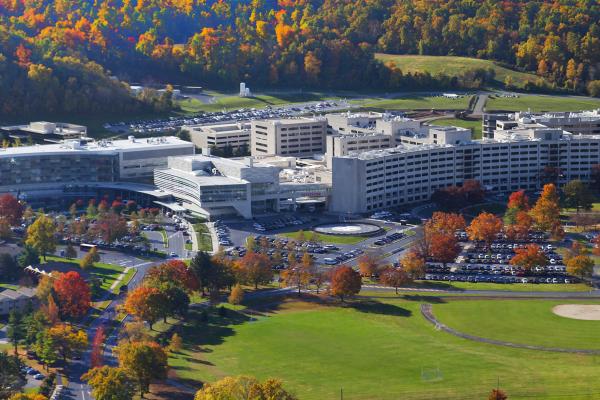Comprehensive Care for Intracranial Aneurysms
Brain aneurysms, also called intracranial or cerebral aneurysms, are abnormal bubbles, blisters or balloon-like pouches that can develop in brain blood vessels. These pouches can burst, causing blood to leak into and around the brain. Approximately 5% of the general population has a brain aneurysm, and 20% of aneurysm patients have more than one aneurysm.
There are many different types of aneurysms. Although most brain aneurysms happen without a known cause or reason, smoking and high blood pressure are known to be associated with their development and rupture.
Rupture is the most feared brain aneurysm complication and is considered a type of stroke. The initial bleeding can be fatal or cause long-term problems, including a build-up of fluid in the brain (hydrocephalus) or narrowing of blood vessels (vasospasm).
Minimizing the Complications of a Brain Aneurysm
At Penn State Health, your specialized cerebrovascular team will discuss your specific type of aneurysm with you, as well as possible treatment options. Using the latest diagnostics, we evaluate the size and location of an aneurysm to make sure the plan best fits your individual needs.
The decision to treat an unruptured aneurysm will be carefully weighed by our expert neurosurgeons. We consider important factors like the size and location of the aneurysm, as well as a person's age and general health.
The goal of treating an aneurysm is to occlude or close/block off before it has a chance to burst. Our neurosurgeons are fellowship-trained in both endovascular and microsurgical techniques. This means you have access to a wide variety of the latest treatment approaches.
Symptoms, Diagnosis and Outlook
Symptoms
A ruptured aneurysm is a medical emergency. If you or a loved one are experiencing ruptured aneurysm symptoms, call 911 right away.
It’s possible to have an aneurysm without having any symptoms. Typically, it’s discovered on a brain MRI or CT that is done for a different reason.
When a brain aneurysm leaks a small amount of blood, it can cause a severe headache that you might describe as “the worst headache of my life.” These headaches are also called a thunderclap or sentinel headache, meaning it’s a warning sign of a potential future rupture.
Aneurysm symptoms can depend on the location of the aneurysm, whether it ruptures and what part of the brain it is pushing on. Brain aneurysm symptoms may include:
- Double vision
- Eye pain
- Headaches
- Loss of vision
- Neck pain
- Ringing in the ears
- Stiff neck
A sudden, severe headache is a symptom you should not ignore - it could mean an aneurysm has ruptured. Other than thee severe headache, the signs of a ruptured aneurysm are similar to usual stroke warning signs. You should remember BE FAST:
- B – balance loss
- E – eyesight changes
- F – face drooping
- A – arm weakness
- S – speech difficulty
- T – time to call 911
Diagnosis
An eye exam can show signs of increased pressure in the brain, including optic nerve swelling or bleeding into the retina of the eye. A clinical exam can also show abnormal eye movement, speech, strength or sensation.
The following tests are also used to diagnose a brain aneurysm and determine the cause of bleeding in the brain:
- Cerebral angiography or spiral CT scan angiography (CTA) of the head
- CT scan of the head
- MRI of the head or MRI angiogram (MRA)
- Spinal tap
Experts in Care
Meet our doctors, view their profiles and select the one that’s right for you.
Find a doctor near youWhy Choose Penn State Health for Care
Penn State Health provides comprehensive, lifesaving care for brain aneurysms. Our multispecialty team includes neurosurgeons, neurologists, neuroradiologists and neurocritical care doctors who offer complete, personalized treatment.
Advancing Brain Aneurysm Surgery
Penn State Health is at the forefront of brain aneurysm surgery. We provide the full range of microsurgical clipping and endovascular procedures using the latest surgical devices. Our team trains doctors on surgical devices at other hospitals so patients outside our circle of care can benefit from the most advanced options.
We’re also involved in researching and developing new devices and techniques to make surgery less invasive, safer and more effective. Some of our newer approaches include:
- Pipeline Embolic Device (PED) to resolve unruptured brain aneurysms that were once considered too difficult to treat
- Woven EndoBridge (WEB) mesh ball implant for wide-neck intracranial aneurysms
- Intracranial stents for brain aneurysm to reduce the risk for stroke
Neurosurgeons with the Highest Expertise
Our neurosurgeons are fellowship-trained in both endovascular and microsurgical techniques. This means they have expertise to perform a range of procedures based on your specific condition. You can get all of your care right here.
State-of-the-Art Angiography Suites and Operating Rooms
The angiography suites and operating rooms at Penn State Health are outfitted with the latest technology. With advanced microscope and exoscope capability, our neurosurgeons are better able to see tiny blood vessels and perform precise procedures for better outcomes.
Brain Aneurysm Screening and Prevention
Risk factors for brain aneurysms include smoking, high blood pressure, alcohol and illegal drug use. Patients with a family history also are at higher risk for an aneurysm, as well as patients with certain medical conditions like polycystic kidney disease, coarctation of the aorta and endocarditis.
We may offer screening to family members with significant family history, or those with two or more first-degree relatives (father, mother or sibling) with a brain aneurysm. You may also be screened if you have a condition that increases your risk for a brain aneurysm.
Support Groups
Support groups provide an opportunity to share your feelings and connect with other patients and caregivers who are experiencing similar struggles.
Convenient Locations
Find the care your family needs, close to home, at one of our many locations throughout central Pennsylvania.
Find a location near you



